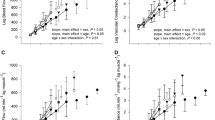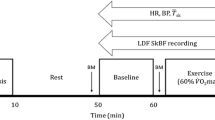Abstract
This study investigated the influence of age, sex, and aerobic capacity on resting and peak forearm and cutaneous blood flow (FBF, CBF). We recruited 93 female and 129 male subjects (age range 16–76 years). FBF and CBF were assessed by plethysmography and laser-Doppler flowmetry, respectively. Peak FBF was obtained following 5 min forearm vascular occlusion and peak CBF in response to local skin heating of 42°C. Blood pressure was measured manually and by Finapres. Maximal oxygen uptake (VO2max) was obtained from a treadmill exercise stress test. Age was associated with declines in resting FBF (y = −1.176 ln(x) + 6.6899, r 2 = 0.45) and peak FBF (y = −17.21 ln(x) + 93.843, r 2 = 0.53) (both p < 0.05). Peak CBF decreased with increasing age (y = −223.6 ln(x) + 1,102.9, r 2 = 0.34) (p < 0.05), but resting CBF was unchanged (p > 0.05). Males had higher resting and peak FBF than females (p < 0.05) and these variables were related to ageing better in males (y = −1.245 ln(x) + 7.188, r 2 = 0.71 and y = −18.53 ln(x) + 102.82, r 2 = 0.69) than in females (y = −1.149 ln(x) + 6.4307, r 2 = 0.38 and y = −16.59 ln(x) + 88.872, r 2 = 0.55). There were no sex differences in resting CBF (p > 0.05). Peak CBF was much better related to ageing in males than females (y = −276.1 ln(x) + 1,365.4, r 2 = 0.53 vs. y = −183.1 ln(x) + 907.86, r 2 = 0.28). VO2max decreased with advancing age and this decline was associated with the decline in peak FBF (y = −0.5933x + 10.91, r 2 = 0.36, p < 0.05) but not with peak CBF (p > 0.05). These results suggest that healthy ageing is associated with a curvilinear decline in resting and peak forearm and peak cutaneous vasodilator capacity, with males more severely affected than females. The data indicate that peak FBF is influenced by VO2max but peak CBF is not.



Similar content being viewed by others
References
Al Suwaidi J, Berger PB, Holmes DR Jr (2000) Coronary artery stents. JAMA 284:1828–1836
Åstrand I (1960) Aerobic work capacity in men and women with special reference to age. Acta Physiol Scand 49:1–92
Behnke BJ, Prisby RD, Lesniewski LA, Donato AJ, Olin HM, Delp MD (2006) Influence of ageing and physical activity on vascular morphology in rat skeletal muscle. J Physiol 575:617–626
Boegli Y, Gremion G, Golay S, Kubli S, Liaudet L, Leyvraz PF, Waeber B, Feihl F (2003) Endurance training enhances vasodilation induced by nitric oxide in human skin. J Invest Dermatol 121:1197–1204
Buskirk ER, Hodgson JL (1987) Age and aerobic power: the rate of change in men and women. Fed Proc 46:1824–1829
Celermajer DS, Sorensen KE, Spiegelhalter DJ, Georgakopoulos D, Robinson J, Deanfield JE (1994) Aging is associated with endothelial dysfunction in healthy men years before the age-related decline in women. J Am Coll Cardiol 24:471–476
Collings KJ (1983) Autonomic failure and the elderly. In: Bannister R (ed) Autonomic failure. Oxford University Press, New York, pp 489–507
Delp MD, Colleran PN, Wilkerson MK, McCurdy MR, Muller-Delp J (2000) Structural and functional remodeling of skeletal muscle microvasculature is induced by simulated microgravity. Am J Physiol Heart Circ Physiol 278:H1866–H1873
Dempsey JA, Seals DR (1995) Aging, exercise, and cardiopulmonary function. In: Lamb DR, Gisolfi CV, Nadel E (eds) Perspectives in exercise science and sports medicine. Exercise in older adults. Cooper Publishing Group, Carmel, IN, 8:237–304
Engelke KA, Halliwill JR, Proctor DN, Dietz NM, Joyner MJ (1996) Contribution of nitric oxide and prostaglandins to reactive hyperemia in human forearm. J Appl Physiol 81:1807–1814
Evans E, Rendell M, Bartek J, Connor S, Bamisedun O, Dovgan D, Giiter M (1993) Thermally induced cutaneous vasodilatation in aging. J Gerontol 48:M53–M57
Fleg JL, O’Connor F, Gerstenblith G, Becker LC, Clulow J, Schulman SP, Lakatta EG (1995) Impact of age on the cardiovascular response to dynamic upright exercise in healthy men and women. J Appl Physiol 78:890–900
Gerhard M, Roddy MA, Creager SJ, Creager MA (1996) Aging progressively impairs endothelium-dependent vasodilation in forearm resistance vessels of humans. Hypertension 27:849–853
Green JS, Stanforth PR, Gagnon J, Leon AS, Rao DC, Skinner JS, Bouchard C, Rankinen T, Wilmore JH (2002) Menopause, estrogen, and training effects on exercise hemodynamics: the HERITAGE study. Med Sci Sports Exerc 34:74–82
Halcox JP, Schenke WH, Zalos G, Mincemoyer R, Prasad A, Waclawiw MA, Nour KR, Quyyumi AA (2002) Prognostic value of coronary vascular endothelial dysfunction. Circulation 106:653–658
Hodges GJ, Kosiba WA, Zhao K, Johnson JM (2008) The involvement of norepinephrine, neuropeptide Y, and nitric oxide in the cutaneous vasodilator response to local heating in humans. J Appl Physiol 105:233–240
Hodges GJ, Kosiba WA, Zhao K, Johnson JM (2009a) The involvement of heating rate and vasoconstrictor nerves in the cutaneous vasodilator response to skin warming. Am J Physiol Heart Circ Physiol 296:H51–H56
Hodges GJ, Sharp L, Stephenson C, Patwala AY, George KP, Goldspink DF, Cable NT (2009b) The effect of 48 weeks of aerobic exercise training on cutaneous vasodilator function in post-menopausal females. Eur J Appl Physiol; Dec 29 [Epub ahead of print]
Hokanson DE, Sumner DS, Strandness DE Jr (1975) An electrically calibrated plethysmograph for direct measurement of limb blood flow. IEEE Trans Biomed Eng 22:25–29
Järvisalo MJ, Toikka JO, Vasankari T, Mikkola J, Viikari JS, Hartiala JJ, Raitakari OT (1999) HMG CoA reductase inhibitors are related to improved systemic endothelial function in coronary artery disease. Atherosclerosis 147(2):237–242
Jasperse JL, Seals DR, Callister R (1994) Active forearm blood flow adjustments to handgrip exercise in young and older healthy men. J Physiol 474:353–360
Johnson JM (1990) The cutaneous circulation. In: Shepherd AP, Öberg PA (eds) Laser-Doppler blood flowmetry. Kluwer, Boston, pp 121–139
Johnson JM, Proppe DW (1996) Cardiovascular adjustments to heat stress. In: Handbook of physiology. Environmental physiology, sect 4, chapt 11, vol 1. American Physiological Society, Bethesda, pp 215–243
Kellogg DL Jr, Liu Y, Kosiba IF, O’Donnell D (1999) Role of nitric oxide in the vascular effects of local warming of the skin in humans. J Appl Physiol 86:1185–1190
Koch DW, Leuenberger UA, Proctor DN (2003) Augmented leg vasoconstriction in dynamically exercising older men during acute sympathetic stimulation. J Physiol 551:337–344
Maiorana A, O’Driscoll G, Goodman C, Taylor R, Green D (2002) Combined aerobic and resistance exercise improves glycemic control and fitness in type 2 diabetes. Diabetes Res Clin Pract 56:115–123
Martin HL, Loomis JL, Kenney WL (1995) Maximal skin vascular conductance in subjects aged 5–85 yr. J Appl Physiol 79:297–301
Minson CT, Holowatz LA, Wong BJ, Kenney WL, Wilkins BW (2002) Decreased nitric oxide- and axon reflex-mediated cutaneous vasodilation with age during local heating. J Appl Physiol 93:1644–1649
Mosca L, Appel LJ, Benjamin EJ, Berra K, Chandra-Strobos N, Fabunmi RP, Grady D, Haan CK, Hayes SN, Judelson DR, Keenan NL, McBride P, Oparil S, Ouyang P, Oz MC, Mendelsohn ME, Pasternak RC, Pinn VW, Robertson RM, Schenck-Gustafsson K, Sila CA, Smith SC Jr, Sopko G, Taylor AL, Walsh BW, Wenger NK, Williams CL (2004) Evidence-based guidelines for cardiovascular disease prevention in women. American Heart Association scientific statement. Arterioscler Thromb Vasc Biol 24:e29–e50
O’Driscoll JG, Green DJ, Ireland M, Kerr D, Larbalestier RI (1997) Treatment of end-stage cardiac failure with growth hormone. Lancet 349:1068
Öberg PA (1990) Laser-Doppler flowmetry. Crit Rev Biomed Eng 18:125–163
Parati G, Casadei R, Groppelli A, Di Rienzo M, Mancia G (1989) Comparison of finger and intra-arterial blood pressure monitoring at rest and during laboratory testing. Hypertension 13:647–655
Pollock ML, Mengelkoch LJ, Graves JE, Lowenthal DT, Limacher MC, Foster C, Wilmore JH (1997) Twenty-year follow-up of aerobic power and body composition of older track athletes. J Appl Physiol 82:1508–1516
Proctor DN, Koch DW, Newcomer SC, Le KU, Leuenberger UA (2003) Impaired leg vasodilation during dynamic exercise in healthy older women. J Appl Physiol 95:1963–1970
Proctor DN, Le KU, Ridout SJ (2005) Age and regional specificity of peak limb vascular conductance in men. J Appl Physiol 98:193–202
Ridout SJ, Parker BA, Proctor DN (2005) Age and regional specificity of peak limb vascular conductance in women. J Appl Physiol 99:2067–2074
Rooke AC, Savage MV, Bregelmann GL (1994) Maximal skin blood flow is decreased in elderly men. J Appl Physiol 77:11–14
Saumet JL, Kellogg DL Jr, Taylor WF, Johnson JM (1988) Cutaneous laser-Doppler flowmetry: influence of underlying muscle blood flow. J Appl Physiol 65:478–481
Sinoway LI, Shenberger J, Wilson J, McLaughlin D, Musch T, Zelis R (1987) A 30-day forearm work protocol increases maximal forearm blood flow. J Appl Physiol 62:1063–1067
Taylor WF, Johnson JM, O’Leary D, Park MK (1984) Effect of high local temperature on reflex cutaneous vasodilation. J Appl Physiol 57:191–196
Vita JA, Keaney JF Jr (2002) Endothelial function: a barometer for cardiovascular risk? Circulation 106:640–642
Whitney RJ (1953) The measurement of volume changes in human limbs. J Physiol 121:1–27
Acknowledgments
We thank the subjects for their participation in the study. Dr. Hodges is now at The University of Western Ontario. Dr. Clements is now at The University of Chichester. This study was supported by the Dunhill Medical Trust, R-36455.
Author information
Authors and Affiliations
Corresponding author
Additional information
Communicated by Niels Secher.
Rights and permissions
About this article
Cite this article
Hodges, G.J., Sharp, L., Clements, R.E. et al. Influence of age, sex, and aerobic capacity on forearm and skin blood flow and vascular conductance. Eur J Appl Physiol 109, 1009–1015 (2010). https://doi.org/10.1007/s00421-010-1441-7
Accepted:
Published:
Issue Date:
DOI: https://doi.org/10.1007/s00421-010-1441-7




